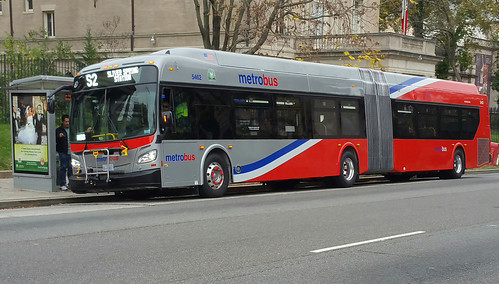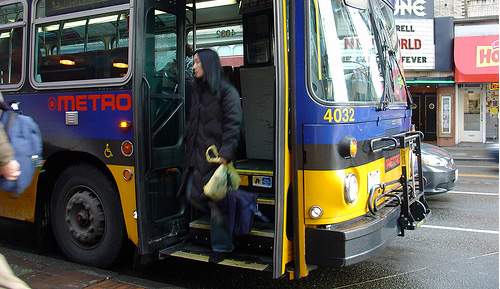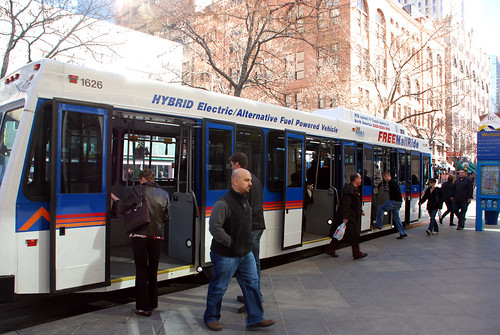The 21 new articulated buses coming to 16th Street, 14th Street, and Georgia Avenue aren’t just prettier than the old buses. They’ll be a little faster, thanks to a more efficient interior layout.

One of the new buses. Photo from WMATA.
Not more buses, but better ones
These new accordion buses replace WMATA’s final remaining old-style articulated buses. When all 21 new ones are running, the last of the old buses with the boxy front will be retired.
Since the 21 new buses replace old ones that are also articulated, don’t expect to see more total articulated buses on 16th, 14th, or Georgia. There will simply be new buses instead of old ones.
But new buses have advantages: They break down less often, so the same number of buses are on the road more often. And their efficient low-floor design speeds up loading and unloading at stops.
Low-floor > high-floor
Riders boarding the old buses have to walk up steps, which creates a bottleneck and slows down service. It takes every able-bodied rider an extra half-second or so to climb bus steps, and less-able ones can take much longer. When a person in a wheelchair comes along, the delay can be significant.

A high-floor bus in Seattle. Photo by Oran Viriyincy.
On lines with very high ridership, all those seconds add up. Delays loading and unloading buses are one of the biggest sources of delay on 16th Street, and there’s no reason to think 14th or Georgia are any different.
Low-floor buses are more like trains—you step in, not up. One fluid and quick movement makes the whole process faster for everyone.

A low-floor bus in Denver. Photo by BeyondDC on Flickr.
With these new buses, WMATA’s articulated bus fleet will now be 100% low-floor. That’s legitimately good news.
A lot’s happening in DC’s busiest bus corridor
Every day there are over 75, 000 bus riders between downtown DC and Silver Spring. 50, 000 of them ride the Metrobus on 16th, 14th, and Georgia alone. Combined, they make up by far the busiest bus corridor in the Washington region.
Getting all those riders through town efficiently is a big task. Buses already come every few minutes on all three streets. In recent years WMATA has added express buses to 16th and Georgia, and DC added a Circulator line to 14th.
Georgia Avenue will get its first bus lanes next year, and tons of improvements are on the table for 16th Street, including maybe bus lanes there too.
All those other things are important. Bus lanes are important. Nobody would suggest low-floor buses solve every problem. But they’re part of the solution, and it’s great to have them.
 Comment on this at the version cross-posted to Greater Greater Washington.
Comment on this at the version cross-posted to Greater Greater Washington.
November 10th, 2015 | Permalink
Tags: bus, transportation













